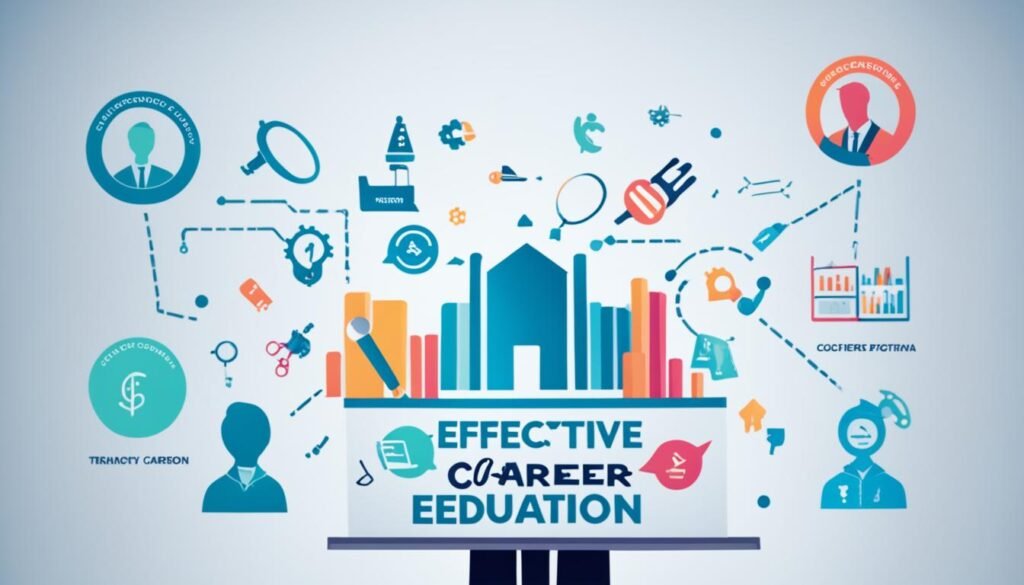In today’s world, career education is more important than ever. It helps people get ready for jobs that are both successful and rewarding. These education systems offer many programs and resources. They aim to give people the knowledge, skills, and advice they need for the working world. This article will look at important parts of these systems.
Also Read: Comparative Jurisdiction: How Different Systems Operate
Key Takeaways
- Comprehensive career education offers crucial resources for finding passions, building skills, and making smart career choices.
- Career education comes in many forms, like traditional school courses, vocational training, and online learning.
- Good career education greatly boosts your chances of getting jobs, helps you move up in your career, and grows the economy.
- It’s essential to tackle issues like how these systems are funded, how easy it is to get to them, and their focus on real job needs. This helps make them better for everyone.
- Now, things like online learning, AI, and VR are starting to change how we learn about careers. They’re creating new chances for people to learn.
Introduction to Career Education Systems
Career education includes many programs and pathways for skill development. It covers everything from learning trades to getting advanced degrees in tech. Knowing about these options is important for those starting or moving up in their careers.
Also Read: The Foundation Of Democracy: Understanding The Constitution
Types of Career Education Systems
For hands-on training, vocational and technical schools are great. They get you ready for specific jobs. Universities and community colleges offer broader education but also help you specialize for your career. And now, you can learn online for many jobs, making it easier to study.
Significance of Career Education
Career education helps prepare us for work life and the job world. With the right skills and knowledge, we are ready for many different jobs. This makes us more likely to get hired, grow our careers, and helps our country get stronger.
“Career education is the foundation upon which individuals can build successful, fulfilling professional lives.”
No matter if you choose vocational training, an associate’s degree, or online courses, these systems are here to help. They give us what we need to keep up with new job opportunities and reach our career goals.
Key Components of Effective Career Education

To create effective career education, mix modern curriculum design with real-world experiences. This requires giving students both technical and soft skills. These soft skills are critical for success in today’s job market.
Also Read: The Process Of Legislation: From Proposal To Law
A good career education curriculum should meet the needs of changing industries. It should mix theory with practical experiences like internships. This helps students prepare for real work situations.
Including practical experience is key in career education. It shows students what their future jobs will really be like. This way, students learn the necessary industry-relevant skills and important soft skills like communication and teamwork.
“Effective career education systems seamlessly blend academic rigor with practical, industry-aligned experiences, empowering students to thrive in their chosen fields.”
The curriculum should also adapt to the job market’s changes. This ensures students have the skills they need for their careers. An ever-evolving curriculum design not only improves effective career education but also makes students more competitive.
Focusing on these components helps create impactful career education programs. These programs prepare students for today’s job challenges. They aid in their long-term career advancement and success.
Benefits of Career Education Systems

Career education systems are vital in boosting job potential and supporting career growth. They help build a skilled workforce. By offering training and qualifications tied to various industries, they make sure people have what they need to get jobs and do well.
Also Read: The Evolution Of The Legal Profession: A History Of Lawyer
Enhancing Employability
Career education systems are great at making people more employable. They teach in ways that match what companies are looking for. This means graduates are ready to work right after school. It helps not just them find jobs, but also helps the economy grow.
Supporting Career Advancement
These systems also help with career progress over time. They provide ways for workers to keep learning and growing. By taking part in training and development programs, people can learn new skills, keep up with what’s new in their fields, and aim for better jobs or higher pay. It boosts both the worker’s satisfaction and the workforce’s strength.
Good career education systems don’t just help any one person succeed. They are key to meeting the economy’s needs by filling spots in highly sought-after jobs. By making people skilled in certain areas, these systems help lessen job gaps and push the nation’s economic growth forward.
“Investing in career education systems is a wise choice for individuals and the economy. These systems improve your chances of getting a job and help you climb the career ladder. As a result, they make our workforce more skilled and exciting.”
Challenges Facing Career Education Systems

Career education systems are always trying to stay relevant. They must face several obstacles to stay up to date and open to all. A big problem is making sure what they teach is up-to-date with what work places need.
Also Read: Roles And Responsibilities Of An Attorney In Modern Legal Systems
Making sure everyone can learn these career skills is also a big challenge. The cost and where people live can stop them from joining these programs. It’s very important to make sure that these programs are affordable and open to all kinds of people.
- Maintaining the relevance of curriculum to industry demands
- Ensuring accessibility to all segments of society
- Providing affordable education options
These obstacles need many different solutions. Educational programs need to change and grow to meet the needs of students and businesses. By working hard on these problems, career education can really help students learn skills they need to succeed in the real world.
“The most important challenge in career education is to keep up with the rapid changes in the job market and ensure that the skills being taught are in high demand.”
Emerging Trends in Career Education

The world of career education is changing fast. It’s all thanks to new digital tech and creative ways to learn and train. Two big trends are the use of digital platforms for learning and the merging of artificial intelligence (AI) and virtual reality (VR) for better training.
Digital Learning Platforms
Now, students can learn differently, all thanks to digital learning. They can set their own pace, learning when it suits them best. This is thanks to online tools and interactive content which make learning more fun than sitting in a traditional class.
Digital platforms bring a lot of benefits. Learning can happen anywhere, making it very flexible. Students can also get lessons that are just right for them, boosting how much they remember and their job skills.
AI and VR for Training
AI and VR are changing how we train for careers, giving students hands-on, real-like experiences. This is a big step up from simply reading or watching lessons. Also, VR lets students practice tasks in a safe, virtual world, getting them ready for real jobs.
With digital, AI, and VR, career education is getting a major upgrade. It’s making learning more fun and personal for students. As these tools get better, they’re sure to be key in getting students ready for today’s jobs.
Success Stories in Career Education Systems

Career education has changed many lives in the United States. These success stories show how career programs can help people find their way and succeed. They do this by giving people the skills they need to do well in their jobs, which in turn helps the economy and the society.
Take Sarah’s story, for instance. After college, she wasn’t sure about her future. She joined a career program, which helped her explore and find job options that were in demand. With training, support, and the right lessons, Sarah got into digital marketing. She landed a great job at a top tech company, all thanks to the program.
“The career education program was a game-changer for me. It not only helped me identify my true career aspirations but also provided me with the practical skills and knowledge to make a successful transition into a thriving field.”
Then there’s John, who worked at a factory that closed due to automation. He decided to join a retraining program. Here, he learned skills like data analysis and programming. This helped him get a good job in the tech world. His success changed his life and made his community stronger.
These success stories in career education show how big economic impacts are made. Good career programs change people’s lives. They also help the economy grow stronger over time. This is the power of giving people the right skills and knowledge.
The need for skilled workers is growing. So, it’s key to offer career education that’s easy to reach and top-notch. The stories above prove how this can make a country thrive. They show the good these programs can do for everyone.
Choosing the Right Career Education Systems
Choosing the right career education system is key for your future. It can greatly impact your career success. Such decisions need thoughtful consideration, matching your personal interests and goals with what the programs offer and industry trends.
Evaluating Program Outcomes
When picking a career education program, be sure to check its outcomes. Look into how many students get jobs and where former students are now. This info gives insights into the program’s quality and its ability to launch successful careers.
Seeing where graduates work now shows if the program prepares students well. Also, checking alumni stories can reveal which programs truly help in career growth and success.
| Program Evaluation Metrics | Importance |
|---|---|
| Employment Rates | Indicates the program’s ability to prepare students for successful job placements |
| Alumni Success Stories | Showcases the program’s impact on graduates’ long-term career trajectories |
| Accreditation and Certifications | Ensures the program meets industry standards and provides recognized credentials |
Choosing a career education program is clearer when you look at the outcomes. This way, students can find programs that are the best fit for their career goals and aspirations.
“The right career education system can open doors to a world of possibilities. By aligning your interests and aspirations with the program’s outcomes, you can embark on a fulfilling journey towards your desired profession.”
The Role of Policy and Legislation

Good career education is built on strong policies and laws. Governments and leaders make rules that guide how we learn for work. They make sure what we learn matches what companies need.
Funding and Accreditation
Getting the right money can make learning for a job easier and cheaper. Leaders should plan money to help these programs grow and last. Also, checking on the programs and making sure they’re good keeps them trustworthy. This means the education you’re getting is valued by everyone.
Quality Assurance Measures
Keeping career education in check is very important. We need checks and balances like looking into programs, how they’re doing and what people think of them. This way, we keep getting better and making sure the education we offer is top-notch.
Governments and leaders can make a big difference by helping with policy and legislation in career education. They also help with funding, accreditation, and making sure what we learn at these programs is good. This makes learning better, makes us better at our jobs, and helps our economy grow.
“Effective career education systems are built on the foundation of well-designed policies and robust legislation.”
Future Directions in Career Education Systems
The world economy and job market are always changing. This means career education is also changing a lot. New technology in education and different needs in industries will lead how students are taught. They will get ready for future jobs in exciting new ways.
This future will highlight using digital learning platforms. These platforms help students learn in ways that fit them best. They offer many career courses and tools, making learning fun and interesting. Students will gain skills necessary to succeed in the global economy.
Using artificial intelligence (AI) and virtual reality (VR) will make learning more real. Students can try different jobs and get instant advice in a safe place. This new way to learn will make sure students are ready for the fast changes in jobs.
“The future of career education lies in its ability to adapt and innovate, ensuring that learners are equipped with the necessary skills and knowledge to succeed in the future of career education.”
Working together is key to making career education better. Schools, businesses, and the government must all help. They will make sure what students learn matches future job needs. This will build a strong workforce that can face any challenge ahead.
Also Read: The Top 10 Universities Worldwide Offering Scholarships
Conclusion
Career education is vital for getting ready to work and boosting the economy. It acts as a link, preparing people for good jobs. It also makes sure companies find skilled and ready workers.
These systems update as industries change. They keep up with new tech and work needs. So, they help us get ready for jobs in the future.
For these systems to work, they need to change quickly. They should use new technology and teaching methods. Investing in them helps everyone succeed in their careers. It also makes our country stronger and more competitive.
FAQs
What are the key components of effective career education systems?
Effective career education mixes the latest curriculum with hands-on experience. This ensures students learn both job-specific skills and important soft skills. These include communication, problem-solving, and teamwork. The curriculum must change with job markets to give students what they need for success.
What are the different types of career education systems?
Career education comes in many forms. It can be vocational training, apprenticeships, or studying at a community college. You can also learn online. Each type focuses on different careers or helps you specialize.
What are the benefits of career education systems?
These systems boost job opportunities and help you move up in your career. They meet the needs of the workforce by training skilled workers. This approach helps people get jobs and do well in their careers. It also benefits the economy by supporting growth.
What are the challenges facing career education systems?
One big challenge is keeping the curriculum up to date. It must match what the job market needs. Making education accessible and affordable for everyone is also hard. Career education must find ways to solve these ongoing issues.
What are the emerging trends in career education?
Digital learning, AI, and VR are changing how we learn about careers. These technologies offer hands-on practice in safe, virtual environments. They make learning exciting and prepare students well.
How can one choose the right career education system?
Choosing the right career education means thinking about what you love and what’s in demand. Look at how successful graduates are in finding jobs. This data can help you see if a program is effective.
What is the role of policy and legislation in supporting career education?
Policies and laws are key to making sure career education is top-notch. They set rules around funding, how to measure success, and quality checks. These rules keep programs strong and credible.
What is the future direction of career education systems?
The future of career education includes more tech and changes in the economy. Schools and programs must keep up to help students succeed in new jobs. Working together with industry and government will be important for guiding change.
Source Links
- https://jscholarship.library.jhu.edu/server/api/core/bitstreams/4947da12-bef3-4c06-a0a1-dad97ae675a4/content
- https://www2.sunybroome.edu/careercenter/wp-content/uploads/sites/20/2019/09/The-Career-and-Education-Planning-Process-by-Frank-Minor-Founder-of-FOCUS-2-Online-Career-and-Education-Systems.pdf
- https://en.aldirassa.com/empowering-futures-navigating-the-landscape-of-career-education-systems/?url=https://ae.aldirassa.com/short/redirect/AbzNgI





